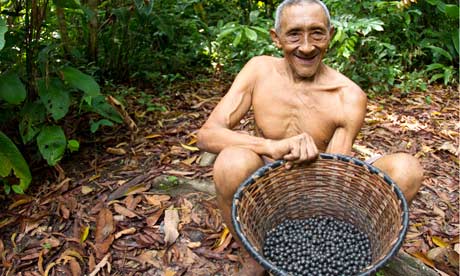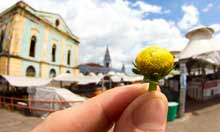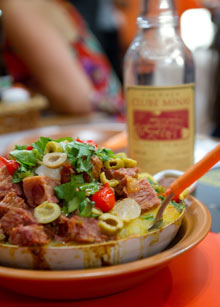Brazilian chefs find culinary inspiration all over the world, but they're also spoilt for choice by an astonishingly diverse range of indigenous ingredients

72-year-old Ladir displays the basket of açaí berries he's collected. Photograph:Beto Lima Fotografia
In the thick forest of the great Amazonian river system near the city of Belém in northern Brazil, 72-year-old Ladir raises a long knife and deftly slices through the thick casing of a pod of castanhas-do-pará; the same long blade gently shaves off the inner shell of a seed within. The nut he offers is familiar - moist, buttery, but with an unexpected hint of coconut - and completely delicious. Having tried it, I'm spoiled forever: the brazil nuts we know do not taste as they do straight from the tree. Ladir leads us (he striding barefoot, we with more tentative steps) between mahogany and pará trees, over flesh-eating ants and through clearings made to ward against snakes, to his plantation, where he disappears 50 feet up one of his açaí palm trees to harvest a weighty branch of berries.
The fruit is much used in Brazilian cooking: liberally in sauces to accompany fried fish, as simple desserts mixed with sugar and tapioca, in smoothies at a thousand sidestreet fruit bars and in palettes of sorbets at Alex Atala's D.O.M. (recently voted the world's fourth best restaurant). It has powered to north America and over the Atlantic, acquiring dubious "superfood" status on the way and spawning thousands of scams as a diet aid. It's an odd, hard little berry that needs to be softened in warm water, was traditionally eaten in the morning by indigenous tribes for energy and is said to taste of the forest. I find it chalky and underwhelming.
 Jambú, or toothache plant. Photograph:Beto Lima Fotografia
Jambú, or toothache plant. Photograph:Beto Lima Fotografia
Across the Guamá river, back among the bustle of Belém, Maria do Carmo sells spicy tacacá soup in cuia gourd bowls on Avenida Nazare. The broth is big flavoured and unlike anything I've ever tried: at first tangy and sour, rich with shrimp and heat from pimenta-de-cheiro, then slowly building into a strange but not unpleasant tingle that numbs the mouth. This is courtesy of leaves from jambú, a flowering herb that's known as the toothache plant. The body of the soup is tucupi, a broth extracted from the manioc root (ubiquitous in Brazil as potatoes are here) and thickened with tapioca gum. Maria's been making it every day for 40 years and has one of the most popular stalls here, thanks, she says, to quality ingredients. She certainly seems to be keeping Anthony Bourdain happy. For me, this fantastic broth is the perfect expression of time and place - I can't imagine it tasting as good anywhere but on the steamy streets of Belém at sunset.
Back down south, in sprawling São Paulo, Brazil's largest and most ethnically diverse city, there's as wide ranging a cuisine as you'd expect. Nowadays, alongside great sushi and Italian food on every street corner courtesy of the largest Japanese population outside Japan and some 15 million Italian residents, Brazilian restaurants are flourishing. The city is not far from Minas Gerais, one of the meatier states in a meaty country, and it's no surprise to find southern style churrascaria, where waiters work rodízio-style, relentlessly carving skewers of charcoal-roasted steak at the table until you wonder if you'll ever need to eat again.
 Heart of palm at D.O.M. restaurant in Brazil. Photograph: Beto Lima Fotografia
Heart of palm at D.O.M. restaurant in Brazil. Photograph: Beto Lima Fotografia
More interesting, though, is the growing number of chefs taking a serious approach to cuisine from different Brazilian regions. In all likelihood many of them have been inspired by their fellow paulistanoAtala who catapulted Brazilian cooking on to the world stage some years back at D.O.M. by combining European techniques with traditional dishes and native and imported ingredients. Take heart of palm, a vegetable that shouts of its tropical environment (Atala uses farmed): he roasts it until it's rich and yielding and introduces the Cantabrian sea in the form of fat salty anchovies. Never was a meeting such pleasure; the memory of that particular dish made the 10,000km journey home with me.
Some distance from the swanky streets around D.O.M., in the decidedly more down-to-earth district of Villa Medeiros, we find Rodrigo de Almeida in the experimental kitchen above his restaurant, Mocotó, musing overAndrew Whitley's Bread Matters, a book that came out of a village bakery in Cumbria. He's a serious, thoughtful young man: "I'm really interested in bread," he tells me earnestly, discussing the importance of terroir, and the cooking of his family home in the sertão, the backwoods of northeastern Brazil.
 Chef Rodrigo de Almeida in the experimental kitchen above his restaurant, Mocotó in São Paulo, Brazil. Photograph: Beto Lima Fotografia
Chef Rodrigo de Almeida in the experimental kitchen above his restaurant, Mocotó in São Paulo, Brazil. Photograph: Beto Lima Fotografia
While he innovates upstairs, conceiving dishes for a first book, they're serving traditional north-eastern dishes at the tables below, where specialities include caldo de mocotó (calf's foot soup) andmocofava, a creamy bone marrow soup with butter beans. Those dishes, and the jovial atmosphere, are the reason Mocotó is rammed every day despite being way up in the north of the city. You can't book but the hours waiting for tables fly when you're stood by the noisy bar choosing the day's best fruit for your caipirinha and snacking on cassava chips or torresmos with orange and lime wedges to squeeze over the crispy pork fat.
It's impossible to overstate the love that Brazilians have for their bar snacks. São Paulo is the latest city in the country to take up the Comida di Boteco, an annual competition devoted to the simple joys of bar food. Small bars, or botecos the city over put up their finest torresmos,empadas, coxinha and other dishes for the public to score alongside service and (importantly) beer temperature.
It's all great fun but with over two million people participating and the extra income and employment generated, comida di boteco is a serious business. The competition was launched back in 2000 in Belo Horizonte,Brazil's bar capital, by local radio personality and boteco enthusiast Eduardo Maya and has now spread to 16 cities across the country. Nowadays you're practically performing a civic duty trawling from bar to bar eating fatty pork and drinking ice cold beer.
 Cupim atolado at Nação Nordestina. Photograph: Beto Lima Fotografia
Cupim atolado at Nação Nordestina. Photograph: Beto Lima Fotografia
We roll up at competing boteco Nação Nordestina on the city's outskirts: waiters bring big bowls ofcupim atolado, a stew of manioc, pepper, and beef slow cooked inmanteiga de garrafa, a type of clarified butter that comes in a bottle and tastes like liquid toffee. I only just manage to stop myself grabbing the communal jug and pouring it down my throat.
As well as celebrating the boteco culture, the competition champions local producers, challenging contestants to cook with native ingredients. Queijo Minas, made by thousands of small scale cheesemakers across Minas Gerais was Belo Horizonte's chosen product and at Patorroco, owner Marcos Machado brings out his winning dish with its take on Arabian cheese, chancliche. The competition clearly encourages creativity, and it's cheering to see how seriously the food is taken, by owners like Machado, as well as the locals opining on his efforts. Theboteco is still at the heart of its community across Brazil - something Britain's struggling publicans could only dream of.
Machado says his search for inspiration for this year's menu will involve leaving the country. Looking outwards is never a bad thing, but given the astonishing diversity of ingredients at his disposal in Brazil - the goliath filhote lurking in the Amazon river, the dizzying array of fruit, the magicjambú - he'd better not stray too far.
No comments:
Post a Comment